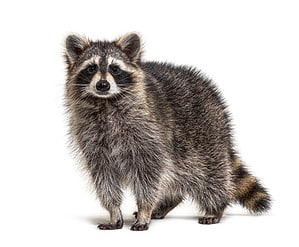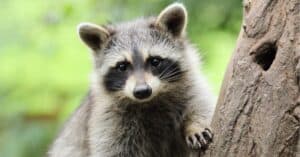Most people see raccoons in one of two ways. Some might see raccoons as adorable little animals that just happen to be found in dumpsters. Others might see them as disease-carrying pests. Regardless of how you might see raccoons, they are important animals that are vital to the ecosystems they live in. But do these animals live in groups? If so, what is a group of raccoons called?
Let’s take a look at what a group of raccoons is called. But first, let’s break down exactly what a raccoon actually is to offer some more context.
What is a Raccoon?
The Procyonidae family of mammals includes raccoons as well as coatis and olingos. Although they have been brought to various regions of the world, raccoons are mostly found in North America. Raccoons, whose scientific name is Procyon lotor, are also referred to as “trash pandas” because of their disguised look and propensity to rummage through waste in residential areas.
Raccoons stand out from other animals thanks to their distinctive look. They have a fur pattern that resembles a black mask over their eyes, which lessens glare and enhances their night vision. They have thick, grayish-brown hair covering their bodies, and their bushy, ringed tails can be employed for communication and balance.
Raccoon Behavior
Raccoons consume both plants and animals since they are omnivores. They eat a range of food items, such as fruits, nuts, insects, small animals, fish, and even trash, as part of their diet. They are opportunistic feeders and will consume any food that is present in their environment.
Because they are essentially nocturnal creatures, raccoons are most active at night. They usually look for cover throughout the day in trees, dens, or other secure places. Raccoons are renowned for their wit and capacity for problem-solving. They have a reputation for being cunning and mischievous creatures because of their ability to use their nimble paws to manipulate items and figure out how to get into things they shouldn’t.
Additionally, raccoons are renowned for their social skills. Although they are normally solitary creatures, they will gather in loose groups during mating and den-building. In the spring, females will give birth to kits, which are litters of two to five pups. Until they are mature enough to go on their own, the kits will spend a number of months with their mother.
These adaptive creatures are often viewed as both a nuisance and a welcome backyard guest since they can survive in a range of environments, including urban settings.
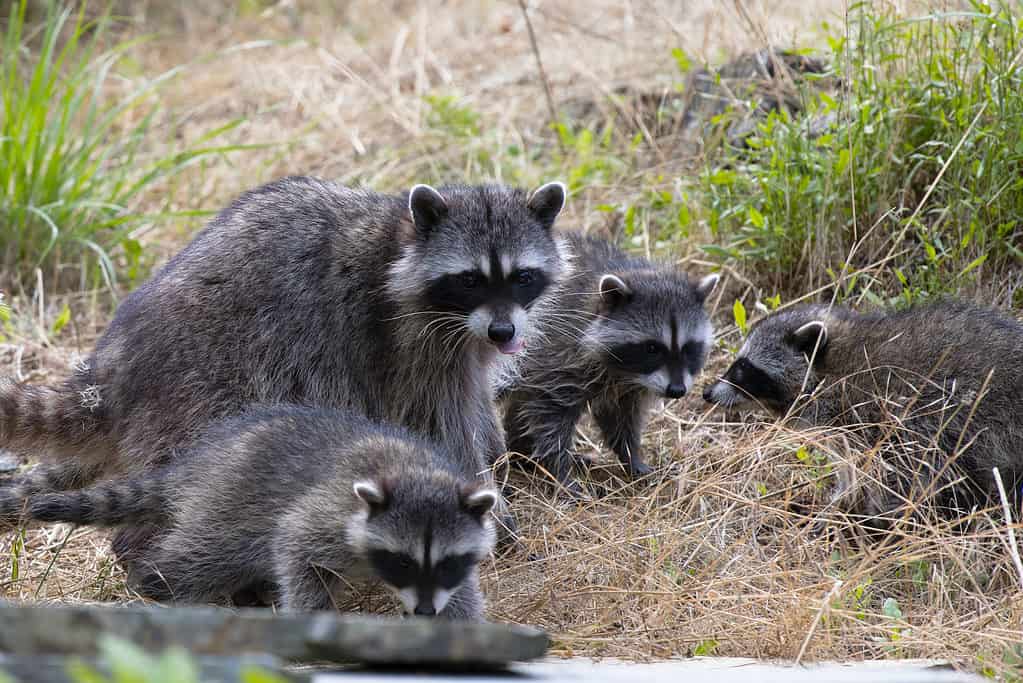
Raccoon kits (pictured) or raccoon babies are susceptible to many predators, so their mothers are particularly protective of them.
©iStock.com/Wirestock
Raccoon Lifespan
Raccoons can live up to two to three years in the wild. They may live for up to 20 long years in captivity. However, we do not advise keeping these animals as pets! In fact, it is illegal in many places to keep wild raccoons as pets.
Raccoons are mostly found in North America, although having lately appeared in several regions of Japan and Europe. These animals typically measure 12 inches in height, 24 to 38 inches in length, and weigh between 14 and 23 pounds. Raccoons are recognized by their gray fur and several black rings that round their tail.
A raccoon constantly rubs and shakes its meal to eliminate detritus before eating it. Some raccoons will even rinse their food in water if there is a nearby water source. However, being clean with their food does not eliminate their chances of contracting rabies. Unusual vocalization, intense aggression, and copious drooling are signs of rabies in raccoons. If you ever encounter one exhibiting these symptoms, get in touch with animal control right away.
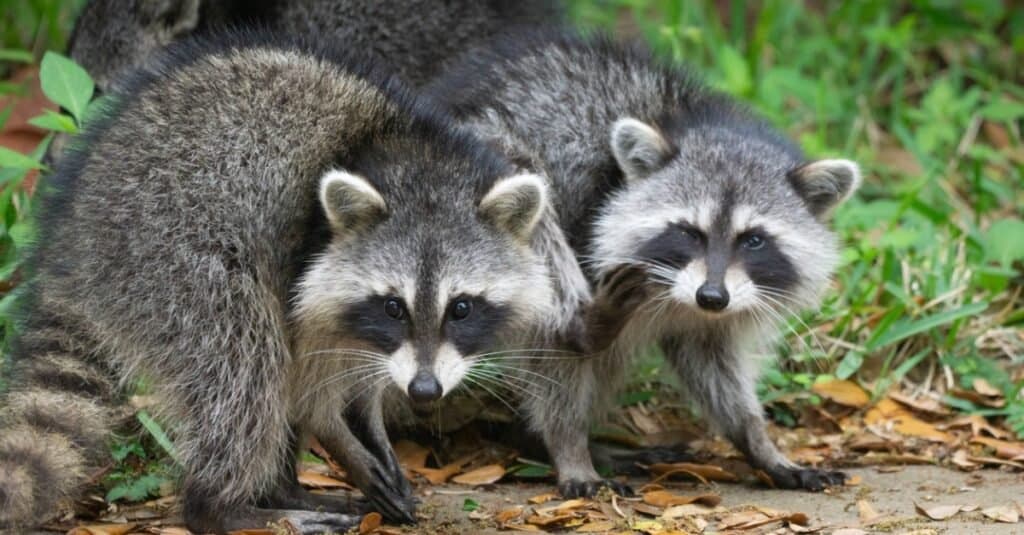
Raccoon groups (pictured) are particularly rare, though babies and their mothers will stick together for a while.
©Mark_Sawyer/Shutterstock.com
A Nursery of Raccoons: All in the Family
Common names for a collection of raccoons include a nursery, a gaze, or a mask. Raccoons are primarily solitary creatures, therefore it’s crucial to remember that seeing them in groups is relatively unusual.
A Nursery of Raccoons
A group of mother raccoons with their young is referred to as a nursery. Since female raccoons often share a den over the winter, a group of raccoons may be caring for and rearing their young at the same time. This behavior is more frequently seen in regions with few denning locations and could be an attempt to increase the odds that their young will survive.
A Gaze of Raccoons
A group of raccoons can also be referred to as a gaze. This phrase is said to have come from the way wild raccoons frequently stand on their hind legs and look carefully at things or other animals in their surroundings. The term “nursery” is a bit more common than “gaze.”
If you’ve ever shined a flashlight at a raccoon and seen it turn its reflected red eyes toward you, you may understand why the term for them is a gaze. Raccoons are likely drawn to people who are in their direct line of sight since they have near-sightedness. They do, however, have great night vision and can see in color.
Dogs that hunted by sight rather than scent were known as gazehounds in the 16th century by hunters. The mistaken belief that raccoons have a weak sense of smell may have led to the use of the word “gaze” to describe a group of raccoons instead. Raccoons are known to raid garbage cans in quest of food because they have the capacity to smell things at a considerable distance.
A Mask of Raccoons
The less common name “mask” for a group of raccoons possibly originated from the fur pattern that raccoons typically have around their eyes, which resembles a black mask. This phrase is not well known or often used, and it is unclear how it came to be connected to packs of raccoons.
Although these phrases are used to characterize raccoon groupings, it is crucial to remember that they are not really seen in the wild. Raccoons are essentially solitary creatures, and the only social behavior they exhibit is during mating and den building. Outside of these situations, it is exceedingly rare to encounter raccoon groups; instead, most sightings involve solitary animals going in search of food or shelter.
A nursery, gaze, or mask are terms used to describe a group of raccoons. Raccoons are usually solitary creatures, therefore it’s crucial to remember that it’s not typical to see them in packs. Raccoon groups are referred to by words based on their behavior or physical qualities, but these terms are not often known or used in ordinary discourse.
What is a Large Gathering of Raccoons Called?
There is no special name for a large group of raccoons. This is simply because they almost never gather in large groups. The largest nurseries of raccoons one will find in a den will include a few mothers and two to five young per mother.
Is It Safe to Interact with Nurseries of Raccoons?
We wouldn’t recommend it. Raccoons are well recognized for being excellent climbers, which makes it easier for them to acquire food and shelter. They can open bottles, doors, jars, and locks because they are incredibly nimble and clever. Raccoons employ more than 200 sounds and have 12 to 15 distinct cries for communication with each other in case of danger.
These very characteristics that set them apart from other animals are what fuel their destructive tendencies. There are many problems that these creatures may cause. These include destroyed gardens, ruined crops, damaged garbage cans, torn roofing, and even damaged chimneys.
Additionally, these animals are known to transmit a number of bacterial illnesses and parasites. Salmonella, leptospirosis, rabies, and roundworm can all be spread to people and pets by accidentally consuming raccoon excrement. It can be transferred to human hands easily if you try to touch a raccoon. You should always be cautious with raccoons, even though there has only ever been one documented human fatality from raccoon rabies in the United States.
Do Male Raccoons Live in a Nursery?
Raccoon males normally live alone and do not form social groupings. When competing for mating chances during breeding season, they may engage with other males, but they do not establish dependable social groupings.
Outside of the mating season, male raccoons are less likely to interact with other individuals and have broader home territories than females. Males often create and defend a territory during the non-breeding season, which may overlap with the territories of other males or females. However, these interactions are usually combative and may include screeching, posturing, and even physical combat. So, to put it simply, raccoon males often live alone and do not form social groupings often.
That being said, groupings do happen. Depending on the circumstance and local population densities, male raccoons can occasionally form loose groups of four or fewer. In the winter or during the mating season, raccoons prefer to congregate in groups on a very short-term basis. This is done to defend themselves from other raccoons who may try to compete with them for the attention of the females. Male groups, however, are less cohesive than female ones and have the propensity to split up more often.

Male raccoons (pictured) can be territorial and aggressive with one another.
©StoneMonkeyswk/Shutterstock.com
How Many Raccoons Live in an Average Nursery?
Like some other animals like wolves or lions, raccoons typically live alone and do not form packs or groups. Raccoons, however, occasionally assemble in places with an abundance of food sources, such as trash cans or bird feeders, and may be spotted together in those places.
In certain instances, particularly during the first year of the kits’ life, female raccoons may reside with their young. The young raccoons will ultimately separate from this gathering to form their own territories.
To put it simply, raccoons do not normally live in packs or groups, but they occasionally band together in places with plenty of food sources. Due to the rarity of these groupings, it is impossible to accurately determine their size. We do know that the minimum size for a group of raccoons would be roughly three because mother raccoons can give birth to two to five young.
Why Don’t Raccoons Enjoy Living in Groups?
Raccoons are solitary animals by nature. They are not instinctually social. Groups will only be formed if it is advantageous or completely necessary. This may be because raccoons have a tendency to be very territorial. They prefer to monitor their own territories without other resource-using raccoons to deal with. Isn’t animal behavior interesting?
Even though there are a few different words used to describe a group of raccoons, you probably will never see such a gathering. These animals are true loners and are rarely assembled in groups unless they are mothers caring for their young. Still, it isn’t impossible!
Why are Raccoons Called Raccoons?
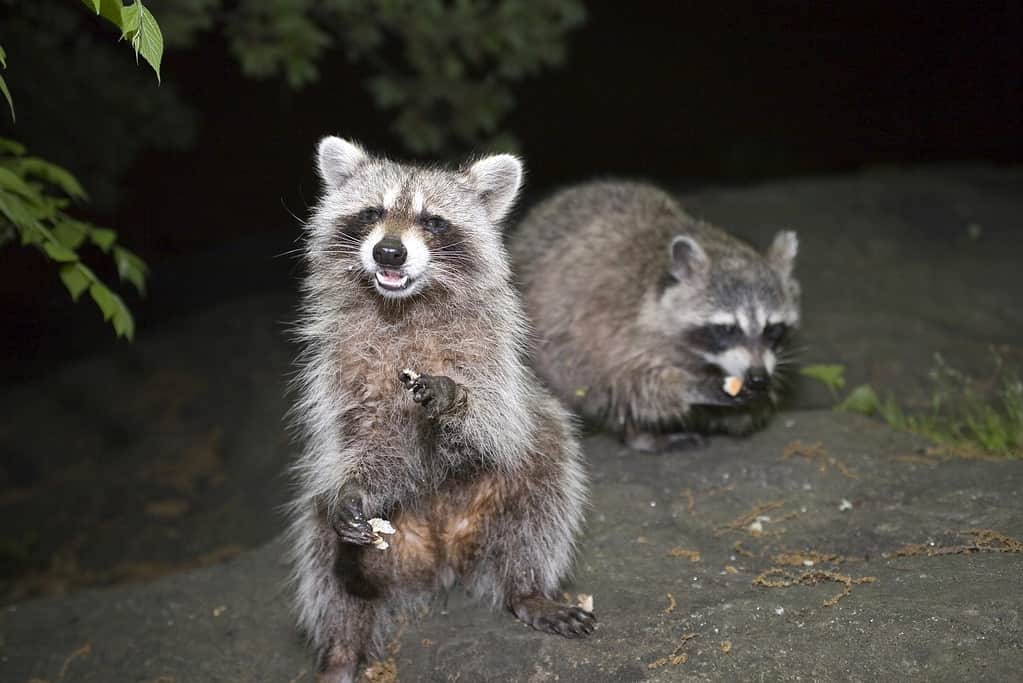
Raccoons’ habits of using their hands for everything from grabbing to washing and scratching became the source of their name.
©iStock.com/eddtoro
Raccoons are endemic to North America, where they are commonly found, and were introduced into the wild in areas of Japan and countries in Europe, like Germany and Russia. Whether this was planned or accidental, they are considered an invasive species in any location other than North America. But where did they get their name and what were they called before that?
The name raccoon is believed to come from the Algonquin Indian word ‘arakun’ which literally translates to ‘he scratches with his hands’ or ‘one who scrubs and scratches with his hands’. While many tribes had a slightly different variation of the word, it has the same meaning. When colonists arrived, they noted words from Powhatan tribes, with one being aroughcun, or arathkone. Colonists eventually changed the word by dropping the ‘a’, making it rakun. It was later given the scientific name of Procyon lotor which translates to ‘before-dog washer’.
The photo featured at the top of this post is © Geoffrey Kuchera/Shutterstock.com
Thank you for reading! Have some feedback for us? Contact the AZ Animals editorial team.




